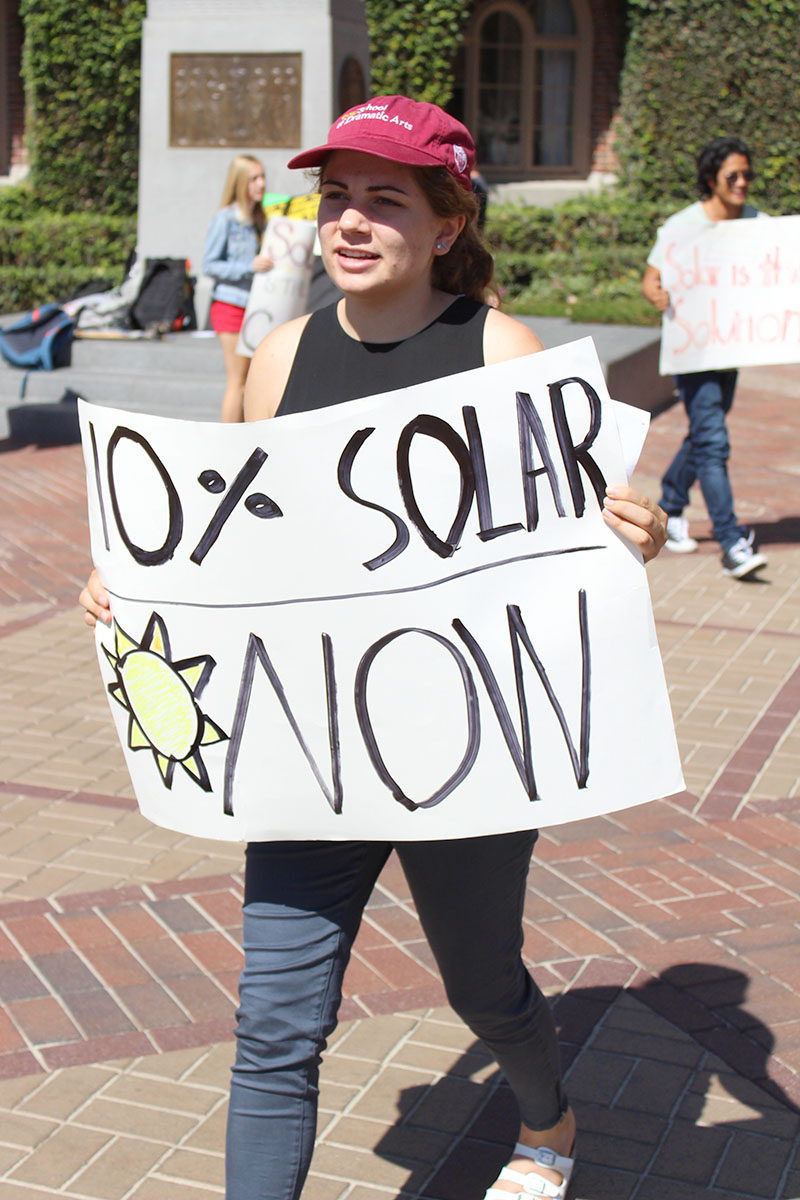Students demand solar energy increase

Julia Erickson | Daily Trojan
Sun’s out · An Environmental Core member holds up a sign near Tommy Trojan to protest the administration’s response to their Go Solar campaign.
Several dozen students gathered at Tommy Trojan Thursday afternoon to demand that USC do more to generate solar power on campus. Students brandished signs with slogans like “I’m disappointed, USC” and “10% solar NOW” while circling Hahn Plaza and chanting in unison.
The rally, which was organized by the Environmental Core under the USC Program Board’s Environmental Student Assembly, was the fourth hosted by the club in the last 12 months. The ESA aids the University’s environmental student groups in promoting sustainable living at USC, and one facet of its programming is the USC Go Solar campaign, which included Thursday’s rally.
Ethan Bialick, who co-directed the Environmental Core before graduating from USC last year, founded the campaign in 2014 with the goal of making USC generate 10 percent of its electricity from solar panels. The club organized three rallies at USC regarding this issue last year, and was able to get 150 signatures on a petition demanding the installation of solar panels on campus.
Zachary Manta, director of the Environmental Core and sustainability advisor to the Undergraduate Student Government, said that he sees the lack of solar energy use on campus as a serious issue.
“This campus, which has 292 days of the sun in a year, doesn’t have any form of on-campus solar generation,” Manta said. “We at USC contribute around 55,000 tons of carbon dioxide to the atmosphere every year through our tremendous energy usage.”
Manta said that people are doing very little to mitigate the generation of carbon dioxide through electricity use and are not doing enough to generate energy that is renewable and carbon-free. The Environmental Core has approached solar companies and consultants to develop proposals for installing solar panels on the Galen Center. According to Manta, however, for many years the administration was unresponsive to the club’s requests.
“We have had a lot of difficulties getting any sort of meetings with the administration, with the energy director or any statement from President Nikias regarding this,” Manta said.
USC announced its Sustainability 2020 plan in November 2015, which provided a framework toward creating a more sustainable school. The plan aims to provide long-term, cost-effective solutions for issues such as water conservation and diversion of waste at USC, which will ultimately reduce greenhouse gas emissions and conserve energy. However, Manta said that it does not do enough to address the issue of solar energy specifically.
“We think it ought to be a lot more ambitious when we think about solar generation on campus,” Manta said.
Sarah Berry, an undeclared sophomore and leader of the Go Solar campaign, said that her personal background drove her to join the Environmental Core freshman year in order to create change on campus, which she said can’t happen without the help of the administration.
“Coming from the Midwest, I thought California would have a bunch of environmental groups, but I was kind of struck by the fact that there wasn’t much going on at USC, especially at the administrative level,” Berry said.
Berry said that the research the Environmental Core brought to USC from places like Solar City solar consultants has not been heard, and their proposals have been rejected. This was the reason club members started organizing the solar rallies.
“We want USC to follow the Sustainability 2020 plan and start implementing it,” Berry said.
This strategy might be working. Manta said that administrators at USC are starting to pay attention to the rallies, supporting the Environmental Core’s initiative and considering moving forward with USC’s energy projects.
“We got a lot of emails and a lot of phone calls,” Manta said. “The administrators are seeing that there are students willing [to take on] this initiative, and it is not purely their energy or financial decision.”
Emily Wan, a sophomore majoring in neuroscience who attended the rally, said that she appreciated the efforts of the Environmental Core and thought they will be effective in creating change. Wan signed the petition for the Go Solar campaign and encouraged students to get involved in making a difference.
“I think that a lot of resources are being wasted in the United States,” Wan said. “We need to speak up, and the club is doing a great job at that.”

Part of the problem may be that USC gets its power from the LADWP. The LADWP doesn’t offer net metering to anyone.
Since the costs for solar installations have become more affordable due to the lower manufacturing costs of the equipment, “Tax incentives” and other monetary gains, the main factor limiting solar power to be viable option for a many building owners the amount of available roof top space to produce enough kilowatts for the project to have a reasonable ROI.